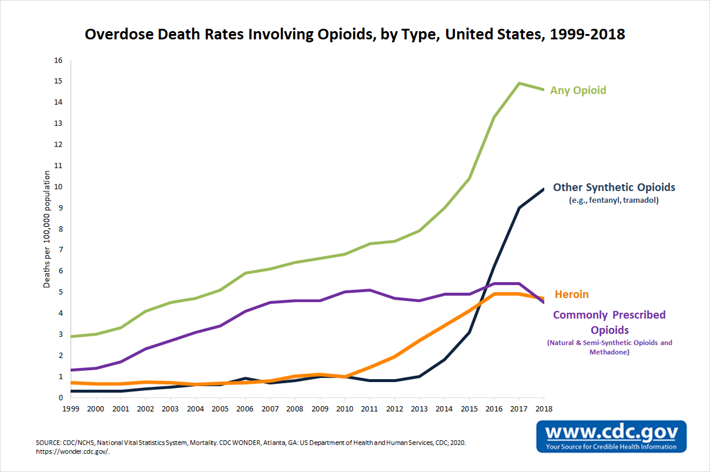After a Long Decline, Drug Overdose Deaths Experience On the Way Up Again

In September 2019, I wrote a perhaps overly optimistic piece about the fact that America was finally seeing a downturn in overdose deaths. In the more than ten years I’d been writing about this topic, I had only seen the steadiest of climbs in these numbers.
For example, in 2006, the first year I went to work at a Narconon drug rehabilitation center, this was our situation:
- Cocaine was the biggest killer by a small margin.
- In second place, heroin, semi-synthetic opioids (painkillers) and similar drugs. But not fentanyl. Yet.
- In third place, methamphetamine.
- The overdose rate per 100,000 people was 11.5.
- We lost approximately 37,000 Americans that year.
That seemed a terrible number of people to lose to drugs. The big concern was overdoses of prescription opioids, especially among young adults.
I had no idea—and neither did anyone else—how much worse things would get.
As I worked at the drug rehab for the next few years and then continued monitoring and writing about the situation after that, my horror grew. In this chart, you can see why.
Instead of losing 11.5 people per 100,000 population, the rate of loss just about doubled. Instead of losing 37,000 people, the number rocketed to nearly 71,000 in 2017. Despite my own despair, I kept researching and writing, and tens of thousands of other people have also persisted in trying to turn the situation around.
And then finally, there was a glimmer of light. The numbers began to tip. It's a small dip, but perhaps cause for hope. Look at the red bar for 2018.

This glimmer of hope showed up first on a website for the Centers for Disease Control and Prevention (CDC) which constantly updates the number of losses to drug overdoses.
This tipping point arrived in December 2017. The month before, the CDC reported 70,723 deaths for the twelve-month-period prior to November 2017. But in December, that number was 70,699. January, it was 70,122.
It was in September 2019 when I wrote that cautiously-optimistic article on the subject. At that time, I had statistics available through April 2018. Here were the CDC’s numbers I quoted in that article:
- August: 69,988
- September: 70,599
- October: 70,690
- November: 70,723
- December: 70,699
- January: 2018 70,122
- February: 69,746
- March: 69,364
- April: 69,040
Even though the decline was modest, it was a bright spot simply because the numbers had been marching up so steadily for so long.
Since then, I’ve checked the CDC database from time to time. When the statistic for March 2019 became available, the decline ended and the graph began to climb again.
The increases are sometimes tiny, maybe fewer than a dozen deaths a year. But it’s simply going in the wrong direction once again.
The CDC’s New Numbers
This chart was retrieved on July 16, 2020. The chart ends with the statistic for December 2019. That month, the CDC reports losses of 70,980. This is higher than any year so far.

I can remember a rally several years ago when parents who had lost children to overdoses met in Washington, D.C. to alert people to the fact that 129 people per day were being lost to overdoses. In 2018, we were losing that many people per day to opioids alone. And methamphetamine is an up-and-coming contender for first place in drug deaths.
Which Drugs are Responsible for the Increases?
The illicit drug fentanyl has been in the headlines for the last few years and a major culprit in causing drug overdose deaths. In the following chart from the CDC, you can see how different types of opioids have surged and then fallen. Fentanyl is represented by the black line. There’s a little bump of fentanyl deaths in 2006, when an illicit lab in Toluca, Mexico was sending their products into the U.S. This lab was put out of business in May 2006 and fentanyl deaths dropped again.

In 2013, overseas labs, primarily in China, began to manufacture fentanyl and ship it into the United States. You can see the drug overdose deaths from synthetic opioids (overwhelmingly fentanyl deaths) tick up a tiny bit that year. Of course, our losses soar after that, as unscrupulous pharmaceutical companies overseas, amoral drug dealers in America and even drug cartels in Mexico all got into the game of manufacturing or transporting this fentanyl.
The RAND Corporation, a research company and think-tank, published the following charts of drugs causing overdose deaths between 2005 and 2017.

The red bar segments reveal the presence of synthetic opioids in the deceased person’s body. Again, this is nearly always a drug from the fentanyl family. In some cases, the individual might have used more than one drug. But it’s not unusual for drug dealers to add fentanyl to their heroin, cocaine or psychostimulant supplies. (The category of psychostimulants mostly includes methamphetamine although it may include a drug like MDMA (Ecstasy) or other party stimulants.)
What’s Happening in the States?
First, there was that dip in 2018. The states enjoying the effects of that dip were Alaska, the District of Columbia, Florida, Georgia, Indiana, Iowa, Kentucky, Maine, Minnesota, New York, North Carolina, Ohio, Pennsylvania, West Virginia, and Wisconsin. States with increases were California, Missouri, South Carolina, New Jersey and Delaware.
During the same time, which states were suffering the highest rates of loss? Not surprisingly (because they have consistently been at the top of the list), Ohio, West Virginia, New Hampshire, Massachusetts, Maryland.
But our focus at the moment is the increase in deaths between late 2018 and late 2019. According to the CDC, the entire U.S. experienced an increase of drug overdose deaths of 4.8% during this time period.
At the top of the list was South Dakota with a 54% increase. Other significant increases occurred in North Dakota (31%), Alaska (27%), District of Columbia (24%), Hawaii (24%), Mississippi (23%), Minnesota (23%), Montana (19%), Wyoming (18%), Connecticut (17%), New Mexico (17%) and California (16%).
At the other end of the scale was Vermont with an 18% decrease. Also seeing decreases were Nevada, Utah, Oklahoma, Arkansas, Missouri, Georgia, Michigan, New York, New Jersey, New Hampshire, Massachusetts, Rhode Island, Maryland, Delaware,
Why?
Unfortunately, our ability to report the numbers on these losses is superior to our ability to identify the exact reasons for the increase. But there's a few things we do know.
As the medical industry educated doctors, dentists and others prescribe lower doses and fewer pills when opioids like Vicodin were handed out, the number of deaths began to slow down. Look at the blue “Rx Opioids” chart just above and you’ll see where the number of deaths topped out. But fentanyl deaths supplanted the prescription opioid deaths and show no signs of slowing down.
Fentanyl is relatively easy to manufacture and it is cheap. Once overseas manufacturers and Mexican drug cartels created an unholy alliance to manufacture and transport this drug across our borders, any vulnerable person in the U.S. was at greater risk of overdose and death.
What Can America Do to Fight Back?
- America needs more drug prevention that has proven to work. This drug prevention needs to be taught in every school, every grade.
- Adults need to be continuously educated that they must set a good drug-free example for their children by drinking moderately, not using illicit drugs, keeping prescription drug use to a necessary minimum, and keeping drugs locked up and out of the reach of children or susceptible adults.
- Medical practitioners need to continue to be educated on prescribing a minimum number of addictive painkillers. They also need education on how to identify an addicted patient and how to help them back to sobriety.
- And there needs to be effective drug rehabilitation available. For most people, this means inpatient or residential treatment for it to be effective. Cravings for more drugs or alcohol are terribly strong early in recovery, and the round-the-clock support of inpatient rehab is vital for many people who wish to get and stay sober.
We can lead our vulnerable Americans back to sobriety and prevent our youth from heading down the path to addiction. But it will take work on all of these fronts, as well as continuing law enforcement actions to take drugs off our streets and incarcerate inhuman drug traffickers.
Sources:
- https://www.kff.org/other/state-indicator/opioid-overdose-death-rates/
- https://www.cdc.gov/mmwr/preview/mmwrhtml/mm5842a1.htm
- https://www.jsad.com/page/news/mar19b
- https://www.cdc.gov/nchs/nvss/vsrr/drug-overdose-data.htm
- https://www.cdc.gov/nchs/data/databriefs/db356-h.pdf
- https://www.justice.gov/archive/ndic/pubs11/20469/index.htm
- https://www.rand.org/content/dam/rand/pubs/testimonies/CT500/CT515/RAND_CT515.pdf
- https://www.narconon.org/drug-abuse/signs-symptoms-heroin-use.html
- https://www.narconon.org/drug-abuse/signs-symptoms-cocaine-use.html
- https://www.narconon.org/drug-information/methamphetamine/
- https://www.cdc.gov/drugoverdose/data/statedeaths/drug-overdose-death-rate-increase-map-2017-2018.html
- https://www.drugabuse.gov/drug-topics/opioids/opioid-summaries-by-state
- https://www.drugabuse.gov/publications/drugfacts/fentanyl


 ®
®